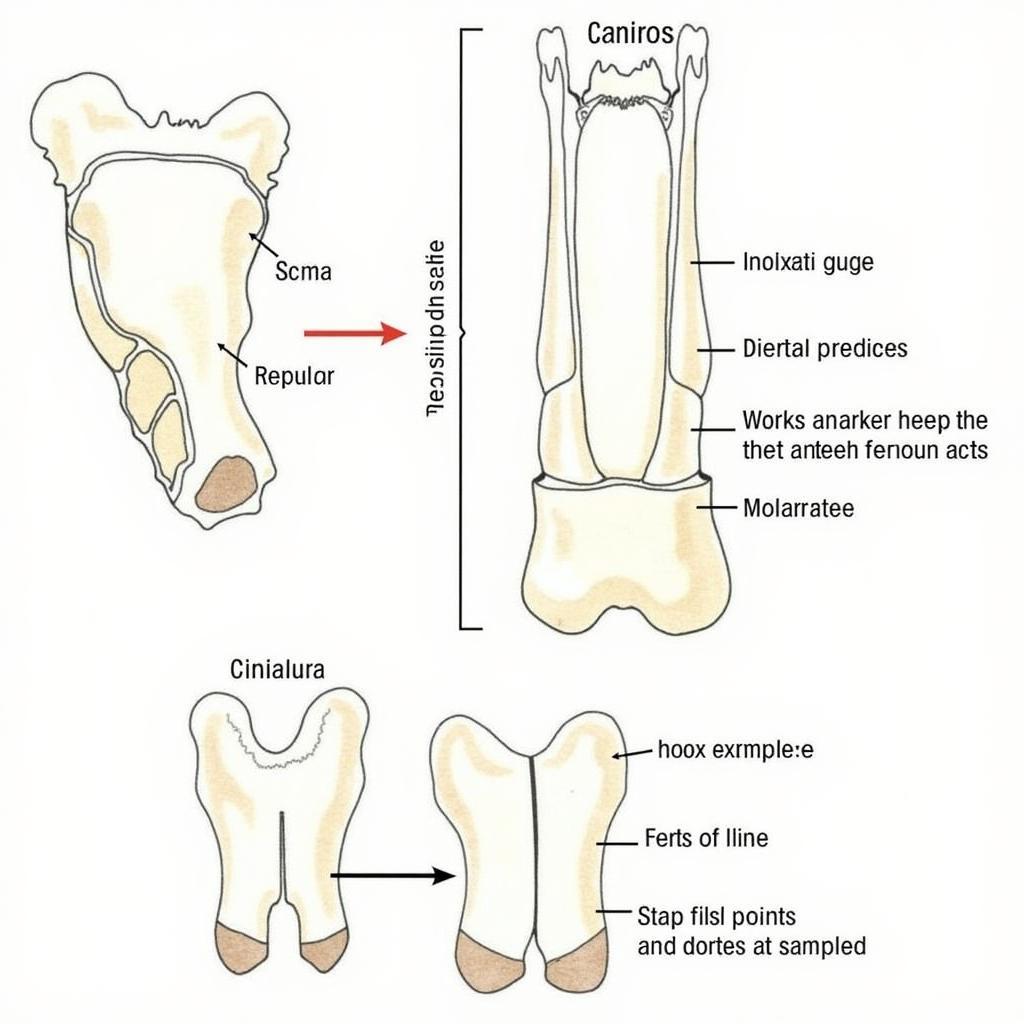A horse dental chart is a crucial tool for equine health management, providing a detailed record of your horse’s dental anatomy and history. It allows veterinarians and equine dentists to track changes over time, diagnose potential issues, and plan appropriate treatment strategies. Understanding how to interpret a horse dental chart can empower owners to actively participate in their horse’s dental care. Let’s dive into the fascinating world of equine dentistry.
Decoding the Equine Dental Chart
Just like humans, horses have baby teeth (deciduous teeth) that are later replaced by permanent teeth. A horse dental chart visually represents the arrangement of these teeth, using symbols and numbers to indicate each tooth’s location, age, and condition. These charts are essential for documenting abnormalities like missing teeth, wolf teeth, sharp enamel points, and other dental issues. Understanding the chart’s layout and symbols is key to unlocking valuable insights into your horse’s oral health.
Why is a Horse Dental Chart Important?
A dental chart provides a baseline for future comparisons. Regular dental exams, combined with accurate charting, enable early detection of problems that might otherwise go unnoticed. Early intervention can prevent minor issues from developing into more serious conditions that could affect your horse’s ability to eat, perform, and maintain overall well-being. For senior horses, a comprehensive dental chart is even more vital, as dental issues can significantly impact their quality of life. Thinking about senior horse care? You might want to check out the best senior feed for horses.
 Example of a Horse Dental Chart
Example of a Horse Dental Chart
Common Symbols and Abbreviations on a Horse Dental Chart
Dental charts use a standardized system of symbols and abbreviations to represent various aspects of a horse’s teeth. These symbols denote the type of tooth (incisor, canine, premolar, or molar), its position in the mouth (upper or lower jaw, left or right side), and its condition (e.g., fractured, missing, rotated). Familiarizing yourself with these symbols will help you interpret your horse’s dental chart effectively.
How to Read a Horse Dental Chart: A Step-by-Step Guide
- Identify the Triadan System: Most horse dental charts utilize the Triadan system, a numbering system that assigns a unique three-digit number to each tooth.
- Locate the Incisors: The front teeth are the incisors, numbered 101-103 on the upper jaw and 201-203 on the lower jaw.
- Find the Canines: Canines, also known as tushes or bridle teeth, are usually found only in male horses, numbered 104/204.
- Identify the Premolars and Molars: The cheek teeth consist of premolars (06-09) and molars (10-11) on both upper and lower jaws, with the corresponding three-digit numbering system.
- Interpret the Symbols: Pay attention to symbols indicating abnormalities like sharp enamel points, hooks, ramps, and other dental issues.
 Horse Teeth Numbering using Triadan System
Horse Teeth Numbering using Triadan System
The Importance of Regular Dental Checkups
Regular dental checkups are crucial for maintaining your horse’s oral health. Horses’ teeth continuously grow and wear down throughout their lives, making regular dental care essential. Early detection and treatment of dental problems can prevent more serious issues and improve your horse’s overall well-being. Looking for quality clippers for grooming? Consider checking out cordless clippers for horses.
“Regular dental care is not just about keeping a horse’s teeth looking good; it’s about ensuring they can eat comfortably and efficiently,” says Dr. Emily Carter, DVM, an equine dental specialist. “A healthy mouth is essential for a horse’s overall health and performance.”
Understanding Common Equine Dental Problems
Horses are susceptible to a variety of dental problems, ranging from sharp enamel points and hooks to more complex issues like periodontal disease and fractured teeth. Understanding these common problems can help you recognize potential issues early on and seek appropriate veterinary care. Thinking of getting a new hat for your next ride? Check out the charlie one horse hat.
“Early detection is key,” adds Dr. Carter. “Regular dental exams, combined with a detailed horse dental chart, allow us to identify and address potential problems before they escalate.”
Conclusion
A horse dental chart is a valuable tool for managing your horse’s oral health. By understanding how to interpret a dental chart, you can become an active participant in your horse’s dental care, ensuring they receive the best possible care. For more specialized senior horse care, consider horse sr. Remember, regular dental checkups and accurate charting are essential for maintaining your horse’s overall well-being.
FAQ
- How often should my horse have a dental exam?
- What are the signs of dental problems in horses?
- What is involved in a typical equine dental exam?
- What are wolf teeth, and why are they sometimes removed?
- How can I maintain my horse’s dental health between checkups?
- What is the cost of equine dental care?
- How can I find a qualified equine dentist in my area?
Need help with horse dental care? Contact us! Phone: 0772127271, Email: [email protected] or visit us at QGM2+WX2, Vị Trung, Vị Thuỷ, Hậu Giang, Vietnam. We have a 24/7 customer support team.